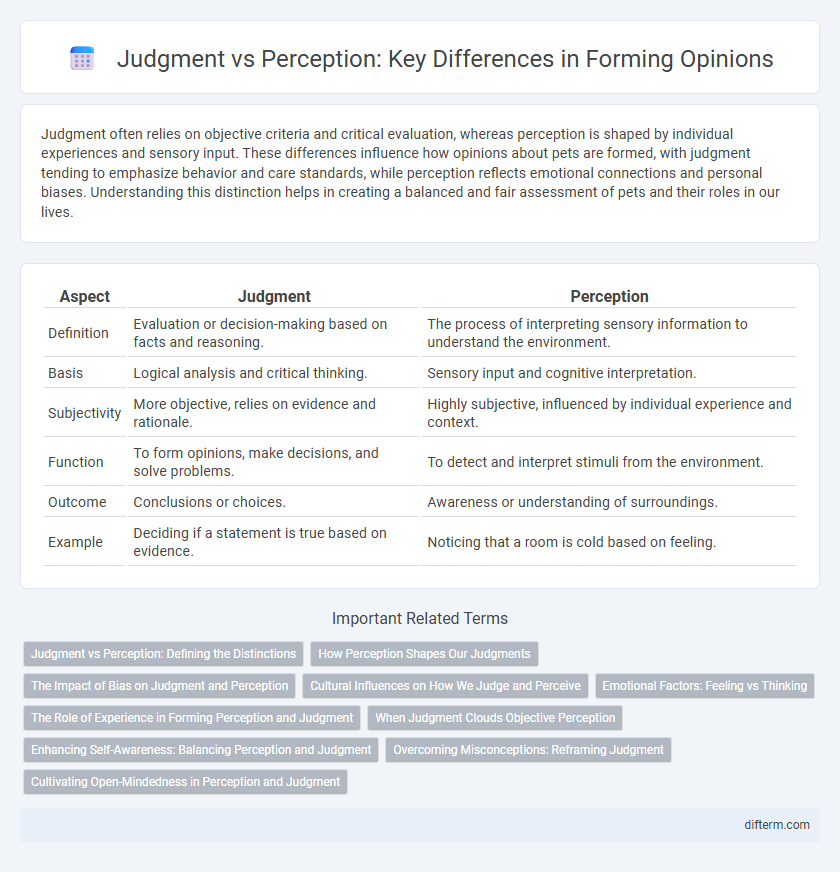Judgment often relies on objective criteria and critical evaluation, whereas perception is shaped by individual experiences and sensory input. These differences influence how opinions about pets are formed, with judgment tending to emphasize behavior and care standards, while perception reflects emotional connections and personal biases. Understanding this distinction helps in creating a balanced and fair assessment of pets and their roles in our lives.
Table of Comparison
| Aspect | Judgment | Perception |
|---|---|---|
| Definition | Evaluation or decision-making based on facts and reasoning. | The process of interpreting sensory information to understand the environment. |
| Basis | Logical analysis and critical thinking. | Sensory input and cognitive interpretation. |
| Subjectivity | More objective, relies on evidence and rationale. | Highly subjective, influenced by individual experience and context. |
| Function | To form opinions, make decisions, and solve problems. | To detect and interpret stimuli from the environment. |
| Outcome | Conclusions or choices. | Awareness or understanding of surroundings. |
| Example | Deciding if a statement is true based on evidence. | Noticing that a room is cold based on feeling. |
Judgment vs Perception: Defining the Distinctions
Judgment involves forming an evaluation or decision based on evidence and reasoning, while perception is the process of interpreting sensory information to become aware of the environment. Judgment requires critical thinking and often incorporates biases or prior knowledge, whereas perception is more immediate and sensory-driven. Understanding these distinctions helps clarify how individuals process information differently, influencing behavior and decision-making outcomes.
How Perception Shapes Our Judgments
Perception acts as the lens through which we interpret information, profoundly influencing the judgments we form about people and situations. Our sensory experiences, combined with cognitive biases and past memories, filter reality in ways that shape subjective opinions rather than objective truths. Understanding the interplay between perception and judgment reveals how personal and cultural factors drive decision-making processes and potentially lead to misinterpretations.
The Impact of Bias on Judgment and Perception
Bias profoundly distorts both judgment and perception, leading individuals to interpret information through a skewed lens that reinforces preconceived notions. Cognitive biases such as confirmation bias and stereotyping alter the evaluation of evidence, often resulting in flawed decisions and inaccurate assessments of reality. Recognizing and mitigating these biases is essential for objective judgment and a more accurate perception of the world.
Cultural Influences on How We Judge and Perceive
Cultural influences shape judgment and perception by embedding specific values, norms, and cognitive frameworks into individual worldviews. People from collectivist societies often prioritize group harmony and social roles in their judgments, while those from individualistic cultures emphasize personal achievements and autonomy. These cultural lenses affect not only what is noticed but also how information is interpreted, leading to divergent conclusions about the same situation.
Emotional Factors: Feeling vs Thinking
Emotional factors significantly influence judgment, where feelings often override logical thinking, shaping decisions beyond objective analysis. Perception filters reality through personal emotions, creating subjective interpretations that affect how information is processed and understood. Recognizing the tension between feeling and thinking in judgment helps reveal biases and promotes more balanced decision-making.
The Role of Experience in Forming Perception and Judgment
Experience significantly shapes perception and judgment by providing a framework through which individuals interpret sensory input and make decisions. Repeated exposure to similar situations enhances pattern recognition, leading to more accurate judgments and refined perceptions. Cognitive biases may emerge as a result of experiential learning, influencing how new information is processed and evaluated.
When Judgment Clouds Objective Perception
Judgment often distorts objective perception by layering subjective biases over raw information, leading to misinterpretations and flawed conclusions. Neuroscientific studies reveal that cognitive biases like confirmation bias activate emotional brain regions, impairing rational analysis and skewing reality processing. Cultivating mindfulness and critical thinking can help individuals dissociate judgment from perception, enhancing clarity and decision-making accuracy.
Enhancing Self-Awareness: Balancing Perception and Judgment
Balancing perception and judgment is essential for enhancing self-awareness, allowing individuals to accurately assess situations while minimizing bias. Developing the ability to differentiate between objective facts and subjective interpretations strengthens emotional intelligence and decision-making skills. This equilibrium fosters personal growth by encouraging reflective thinking and reducing impulsive reactions based on flawed judgments.
Overcoming Misconceptions: Reframing Judgment
Reframing judgment involves shifting from snap opinions to deeper understanding by questioning initial perceptions and recognizing inherent biases. Overcoming misconceptions requires active empathy and the willingness to seek context beyond surface-level interpretations. This process transforms judgment into informed awareness, promoting more accurate and fair assessments of people and situations.
Cultivating Open-Mindedness in Perception and Judgment
Cultivating open-mindedness in judgment and perception enhances cognitive flexibility by allowing individuals to evaluate information without bias. This approach promotes a deeper understanding of diverse viewpoints, fostering empathy and reducing prejudgment. Encouraging awareness of cognitive biases and actively questioning assumptions sharpens perceptual accuracy and leads to more balanced, informed decisions.
judgment vs perception Infographic

 difterm.com
difterm.com